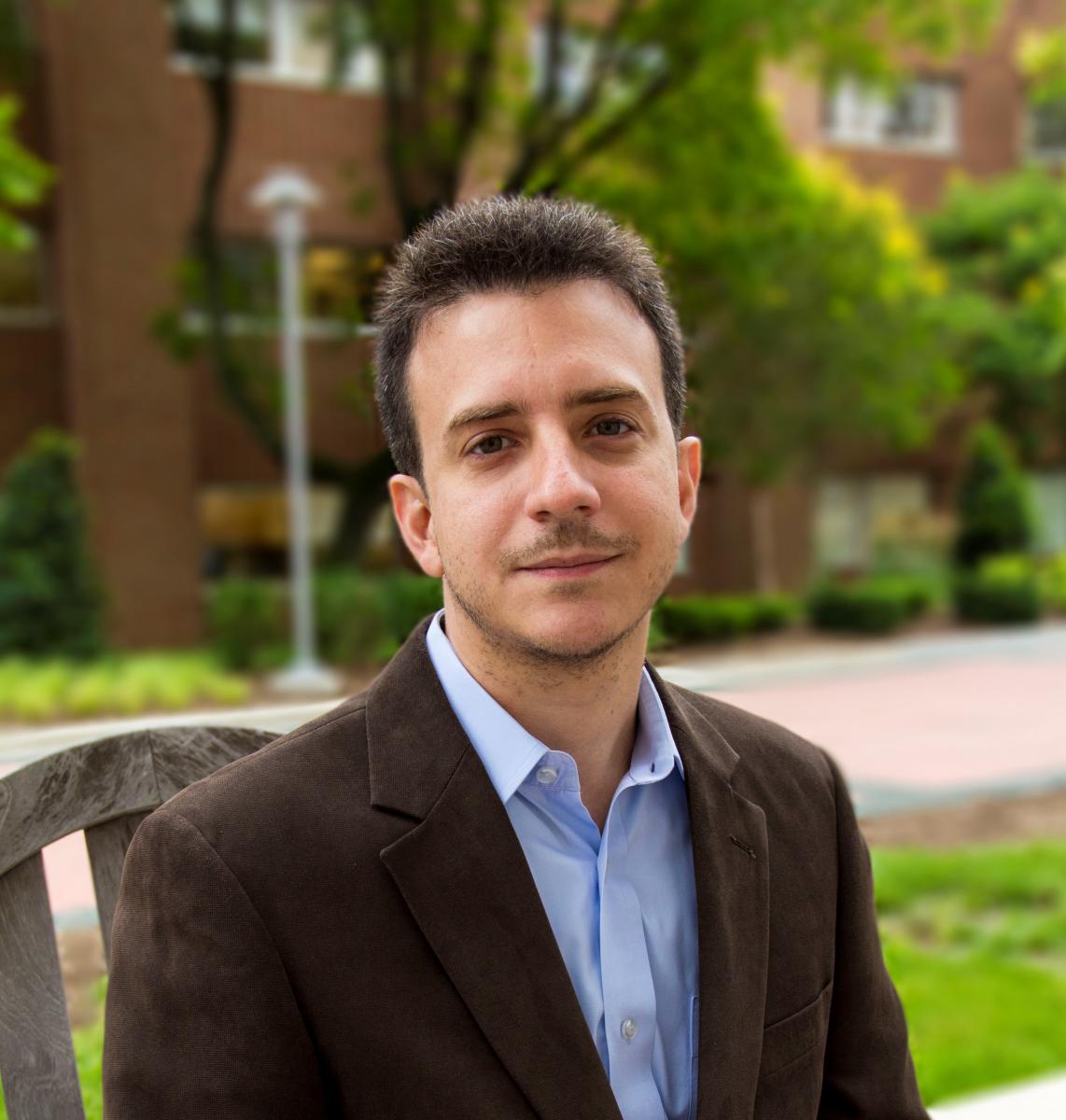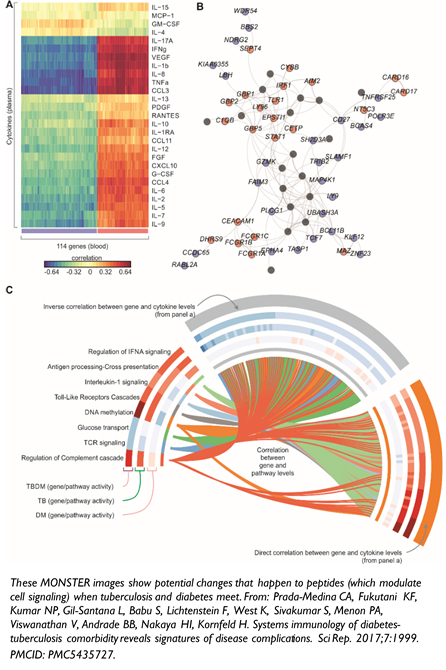Connecting the Dots: Johns Hopkins Visiting Professor of Infectious Diseases Dr. Bruno Andrade
 Authored by Molly Bowen
Authored by Molly Bowen
Ninteenth century post impressionist artist Georges Seurat applied logic and mathematics to individual dots of color to impose order, create structure, and confer meaning to what, close up, appears as beautiful chaos. Using a strikingly similar approach, Dr. Bruno Andrade creates meaning from huge data sets of clinical samples from tuberculosis patients. Taking inspiration from forecast models used by economists and meteorologists to map data, analyze patterns, and predict trends, he and his research team impose order on the tiniest fragments of human composition to create pictures that portend how diseases will react in populations of patients. The content and configurations of Andrade’s “paintings” is determined by variations in diseases and in people, and how they interact. But we’ll get into more about the paintings later.
A trained physician and pathologist, Andrade returned to his native Brazil following post doctoral studies at the U.S. National Institutes of Health; it was during that time that he learned how to build clinical research sites. Upon his return home, he joined the Pathology and Infectious Diseases arm of Fundação Oswaldo Cruz (FIOCRUZ), Brazil’s NIH, where he established a research lab. When Andrade needed clinical samples to conduct his work, he formed partnerships with hospitals.
Andrade’s team conducts studies on the human body’s response to diseases, including tuberculosis and HIV. Using samples of blood, urine, sputum, saliva, and hair, researchers characterize, detect interactions among, and measure changes in DNA, RNA, proteins, and metabolites in people who are infected. Some patterns, changes, or interactions (or biomarkers) sound an alarm that severe disease or death is the most likely outcome for certain groups of TB and HIV patients. Findings from research have a real impact—they can change global standards for patient care, guide the direction of future research in functional genomics, and identify priorities for development of drugs and vaccines that neutralize the disease-producing characteristics of specific targets.
Over the course of just four years, Andrade has had remarkable success creating what he needed to conduct research, even if success came in fits and starts. He established Fundação José Silveira, a philanthropically supported organization that includes a hospital and 5 clinical sites. He crafted a business model to sustain the foundation in which revenues from the hospital’s procedures are invested directly back into TB research. “We make the money, we spend the money, so it’s a very good marriage,” Andrade chuckled.
The clinical sites participate in the Regional Prospective Observational Cohort for Tuberculosis (RePORT) Consortium, an international collaboration of country-level efforts to establish clinical sample repositories and conduct TB biomarker research. The raison d'etre of RePORT is to identify what biological conditions and interactions make some people more likely than others to die or to suffer from severe disease. Countries that participate in the RePORT Consortium represent those with the highest global burden of TB disease—India, Brazil, South Africa, China, Indonesia, and the Philippines. Institutions in each of the countries are paired with U.S. institutions. Under the leadership of CCGHE Deputy Director Dr. Amita Gupta, Johns Hopkins University co-leads the country-wide effort in India and is a partner in two biomarker research consortia—one with the National Institute for Research in Tuberculosis (Chennai) and BJGMC (Pune), and the other with PD Hinduja Hospital and Medical Group (Mumbai).
Genetic diversity found among the 5 sites in Brazil paints a complex picture of how TB affects patients and how best to treat them. There is a clinical site in Salvador, which is also home to the national biorepository—strategically located there for convenient storage and economical shipment of clinical samples. “The Portuguese founded Brazil; they started colonization from Salvador, and they brought slaves from Africa, so Salvador is very rich in African genetics. So here we have many diseases that are commonly seen in African populations.” Manauos, a site located in the Amazon, is greatly affected by HIV. “The reasons why we have more HIV there are not really clear, but we believe that it’s because it’s difficult to have access to medical care in that region of Brazil. The level of immunosuppression we see at the clinic is advanced,” Andrade said. Further south, there are 3 sites in Rio de Janeiro, where the genetic background is European.
Andrade emphasized the importance of collaborative international efforts, “We want to understand factors that are associated with different disease outcomes—such as death, treatment failure, relapse, intersection of TB and HIV. And the factors are unique to geographical location, so disease epidemiology, types of pathogens, are different in Brazil than in other participating RePORT countries like India, and they’re different in South Africa. We find differences in every aspect that we look for. So that’s why it’s important to study different sites.”
His research base has expanded far beyond the borders of Brazil. “We have facilities and a lab in Brazil, but also a lab at University of Cape Town, and we have appointments in India. I thought if we can work together answer big picture questions, I can not only study diversity in my own country, but I can study diversity around the globe. And that was a very cool idea.”
In an effort to better understand the big picture, Andrade broke out his data analysis paintbrush. His team adapted visualization modeling approaches used in other fields and worked on developing algorithms that translated very specific data from patients into graphics that depicted disease pathogenesis at the population level. In Seurat fashion, Andrade’s team uses dots to make paintings that tell stories.
“We run very complicated modeling with multiplatform data—data from genomics (DNA), transcriptomics (RNA), proteomics (proteins), metabolomics (metabolites), epidemiological data—to look for insights in biology.” Andrade continues, “It’s very trying to figure out which patients will need a specific type of care, so we deconvolute very complex information.”
Andrade likens clinical data modeling to weather prediction modeling, “If I give you information on temperature, you will not be able to tell me if it’s going to rain tomorrow. If I give you information on temperature and humidity, you still won’t be able to predict this with certainty. But if I show variables—temperature, humidity, number of clouds in the sky, what specific direction they are going in—and how they correlate with each other, and I show historically how these things behave, now you can predict. This is important, because the way that we look at the data, it’s not just seeing that one gene has increased expression in people that die, it’s seeing how the genes are being coordinated, and how they relate their expression with other genes—the relationships inform the predictions.”
“In order to be a good scientist, you need to accept complexity. If you’re a student pursuing clinical science, the first thing you must grasp is the beauty of complexity. And instead of trying to fight against it, we ask, ‘how can I digest complexity and come out with something useful?’ ”
 Andrade soon found that there was value not only in his scientific results, but also in the ability to tell a story through the artistry of visual mapping. “We started showing this to funders—that we could produce novel information, that we could model the science. They were interested and we realized we could generate revenue that we could invest in strategic areas that we think are important for our group.” This is how the MONSTER (Multinational Organization Network Sponsoring Translational and Epidemiological Research) laboratory was born.
Andrade soon found that there was value not only in his scientific results, but also in the ability to tell a story through the artistry of visual mapping. “We started showing this to funders—that we could produce novel information, that we could model the science. They were interested and we realized we could generate revenue that we could invest in strategic areas that we think are important for our group.” This is how the MONSTER (Multinational Organization Network Sponsoring Translational and Epidemiological Research) laboratory was born.
MONSTER is a fee-for-service big data analytics NGO that has built an impressive list of global clients willing to pay big money to have their data shaken and served. “We help clients digest their complex data and help them to visualize the data differently. And that’s a paid service. And we use that to invest in infrastructure like computers and servers or in young and promising investigators who need funding.”
As the adage goes, success breeds success; Andrade’s group is now highly attractive to big name funders. “That’s when everything happened.” he said. He laughed “Now it’s larger than what I think we can handle. Of course I’m joking—it’s been a lot of fun.”
With Fundação José Silvera and MONSTER, Andrade carved out a space to create informative and glorious pictures of disease reactions that are composed of tiny data points. Georges Seurat once said “Some say they see poetry in my paintings; I see only science.” Similarly, Andrade’s work makes art from science. Unlike Seurat, Andrade’s business model doesn’t rely solely on external funding from admiring benefactors.
